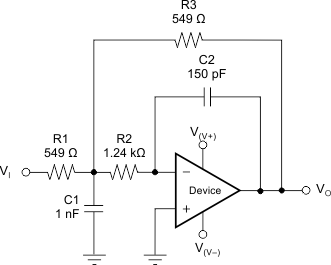SBOS235F March 2002 – April 2018 OPA2357 , OPA357
PRODUCTION DATA.
- 1 Features
- 2 Applications
- 3 Description
- 4 Revision History
- 5 Pin Configuration and Functions
- 6 Specifications
-
7 Detailed Description
- 7.1 Overview
- 7.2 Functional Block Diagram
- 7.3
Feature Description
- 7.3.1 OPAx357 Comparison
- 7.3.2 Operating Voltage
- 7.3.3 Enable Function
- 7.3.4 Rail-to-Rail Input
- 7.3.5 Rail-to-Rail Output
- 7.3.6 Output Drive
- 7.3.7 Video
- 7.3.8 Wideband Video Multiplexing
- 7.3.9 Driving Analog-to-Digital Converters
- 7.3.10 Capacitive Load and Stability
- 7.3.11 Wideband Transimpedance Amplifier
- 7.4 Device Functional Modes
- 8 Application and Implementation
- 9 Power Supply Recommendations
- 10Layout
- 11Device and Documentation Support
- 12Mechanical, Packaging, and Orderable Information
Package Options
Mechanical Data (Package|Pins)
- DGS|10
Thermal pad, mechanical data (Package|Pins)
Orderable Information
8.2.4 Active Filter
The OPAx357 family of devices is designed for active filter applications that require a wide bandwidth, fast slew rate, low-noise, single-supply operational amplifier. Figure 46 shows a 500-kHz, second-order, low-pass filter using the multiple-feedback (MFB) topology. The components are selected to provide a maximally-flat Butterworth response. Beyond the cutoff frequency, roll-off is –40 dB/dec. The Butterworth response is designed for applications requiring predictable gain characteristics, such as the antialiasing filter used in front of an A/D converter.
One point to note when considering the MFB filter is that the output is inverted relative to the input. If this inversion is not required, or not desired, a noninverting output can be achieved through one of the following options:
- Adding an inverting amplifier
- Adding an additional second-order MFB stage
- Using a noninverting filter topology, such as the Sallen-Key (see Figure 47).
MFB and Sallen-Key, low-pass and high-pass filter synthesis is accomplished using TI’s FilterPro™ program. This software is available as a free download on www.ti.com.
 Figure 46. Second-Order, Butterworth, 500-kHz, Low-Pass Filter
Figure 46. Second-Order, Butterworth, 500-kHz, Low-Pass Filter
 Figure 47. OPAx357 Configured as a Three-Pole, 20-kHz, Sallen-Key Filter
Figure 47. OPAx357 Configured as a Three-Pole, 20-kHz, Sallen-Key Filter